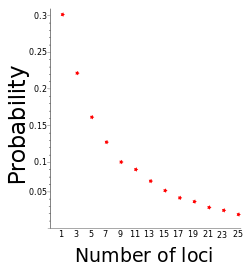- "Human genetic diversity: Lewontin's fallacy" (scientific paper)
-
Infobox
Multi-Locus Allele Clusters

In a haploid population, when a single locus is considered (blue), with two alleles, + and - we can see a differential geographical distribution between Population I (70% +) and Population II (30% +).
When we want to assign an individual to one of these populations using this single locus we will assign any + to population I because the probability (p) of this allele belonging to Population I is p = 0.7, the probability (q) of incorrectly assigning this allele to Population I is q = 1 − p, or 0.3. This amounts to a Bernoulli trial because the answer to the question "is this the correct population?" is a simple yes or no. This makes the test Binomially distributed but with a single trial.

But when three loci per individual are taken into account, each with p = 0.7 for a + allele in Population I the average number of + alleles per individual becomes kp = 2.1 (number of trials (k = 3) × probability for each allele (p = 0.7)) and 0.9 (3 × 0.3) + alleles per individual in Population II. This is sometimes referred to as the population trait value. Because alleles are discrete entities we can only assign an individual to a population based on the number of whole + alleles it contains. Therefore we will assign any individual with three or two + alleles to Population I, and any individual with one or fewer + alleles to population II.

The binomial distribution with three trials and a probability of 0.7 shows that the probability of and individual from this population having a single + allele is 0.189 and for zero + alleles it is 0.027, which gives a misclassification rate of 0.189 + 0.027 = 0.216, which is a smaller chance of misclassification than for a single allele. Misclassification becomes much smaller as we use more alleles. When more loci are taken into account, each new locus adds an extra independent test to the binomial distribution, decreasing the chance of misclassification.

Human genetic diversity: Lewontin's fallacy is a 2003 paper by A. W. F. Edwards that refers to an argument first made by Richard Lewontin in his 1972 article The apportionment of human diversity[1], which argued that race for humans is not a valid taxonomic construct. Edwards' paper criticized and acted as a rebuttal to this conclusion.[2] Although academic texts generally avoid referring to Edwards' counterargument in the polemicist terms from Edwards' original title, Edwards' critique nevertheless is mentioned in a number[quantify] of subsequent academic books and popular science books that discuss Lewontin's argument.[3][4]
Contents
Lewontin's argument
In the 1972 study "The apportionment of human diversity" Richard Lewontin performed a fixation index (FST) statistical analysis using 17 markers including blood group proteins. His results were that the majority of genetic differences between humans, 85.4%, were found within a population, 8.3% of genetic differences were found between populations within a race, and only 6.3% was found to differentiate the various races which in the study were Caucasian, African, Mongoloid, South Asian Aborigines, Amerinds, Oceanians, and Australian Aborigines. (Later studies have generally agreed although sometimes with somewhat different values such as 75% for variation within a population.[5]) Lewontin argued "Since such racial classification is now seen to be of virtually no genetic or taxonomic significance either, no justification can be offered for its continuance."
This argument has been cited as evidence that racial categories are biologically meaningless, and that behavioral differences between groups cannot have any genetic underpinnings.[6] One example being the "Statement on 'Race'" published by the American Anthropological Association in 1998 which rejected the existence of races as unambiguous, clearly demarcated, biologically distinct groups.[7]
Edwards' critique
See also: Race and geneticsEdwards argued that while Lewontin's statements on variability are correct when examining the frequency of different alleles (variants of a particular gene) at individual locus (the location of a particular gene) between individuals, it is nonetheless possible to classify individuals into different racial groups with an accuracy that approaches 100% when one takes into account the frequency of the alleles at several loci at the same time. This happens because differences in the frequency of alleles at different loci are correlated across populations — the alleles that are more frequent in a population at two or more loci are correlated when we consider the two populations simultaneously. Or in other words, the frequency of the alleles tends to cluster differently for different populations.[8]
In Edwards' words, "most of the information that distinguishes populations is hidden in the correlation structure of the data." These relationships can be extracted using commonly-used ordination and cluster analysis techniques. Edwards argued that, even if the probability of misclassifying an individual based on the frequency of alleles at a single locus is as high as 30% (as Lewontin reported in 1972), the misclassification probability becomes close to zero if enough loci are studied.[9]
Edwards' paper stated that the underlying logic was discussed in the early years of the 20th century. Edwards wrote that he and Luigi Luca Cavalli-Sforza had presented a contrasting analysis to Lewontin's, using very similar data, already at the 1963 International Congress of Genetics. Lewontin participated but did not refer to this in his later paper. Edwards argued that Lewontin used his analysis to attack classification which he deplored for social reasons, such as Arthur Jensen's research on race and intelligence.[9]
Evolutionary biologist Richard Dawkins agreed with Edwards' view and summarized it as "However small the racial partition of the total variation may be, if such racial characteristics as there are highly correlate with other racial characteristics, they are by definition informative, and therefore of taxonomic significance."[3][verification needed] Neven Sesardic has argued that, unbeknownst to Edwards, Jeffry B. Mitton already made the same argument about Lewontin's claim in two articles published in The American Naturalist in the late 1970s.[10]
Biological anthropologists such as Jonathan Marks and philosopher Jonathan Kaplan have argued that while Edwards argument is correct it does not invalidate Lewontin's original argument, because the fact that racial groups can be seen to be genetically distinct on average does not mean that racial groups are the most basic biological divisions of the world's population. Nor does it mean that races are not social constructs as is the prevailing view among anthropologists and social scientists, because the particular genetic differences that correspond to races only become salient when racial categories take on social importance. According to this view Edwards and Lewontin are therefore both correct. [11]
Similarly, Marks agree with Edwards that correlations between geographical areas and genetics obviously exists in human populations, but goes on to note that "What is unclear is what this has to do with "race" as that term has been though much in the twentieth century - the mere fact that we can find groups to be different and can reliably allot people to them is trivial. Again, the point of the theory of race was to discover large clusters of people that are principally homogeneous within and heterogeneous between, contrasting groups. Lewontin's analysis shows that such groups do not exist in the human species, and Edwards' critique does not contradict that interpretation."[12]
The view that while geographic clustering of biological traits does exist this does not lend biological validity to racial groups was proposed by several evolutionary anthropologists and geneticists prior to the publication of Edwards critique of Lewontin.[13][14][15][16][17]
See also
- Race and genetics
- Human genetic clustering
- Population groups in biomedicine
References
- ^ Made in The apportionment of human diversity (1972)
- ^ Edwards AW (August 2003). "Human genetic diversity: Lewontin's fallacy". BioEssays 25 (8): 798–801. doi:10.1002/bies.10315. PMID 12879450.
- ^ a b Dawkins, Richard; Wong, Yan (2005). The Ancestor's Tale: A Pilgrimage to the Dawn of Evolution. Houghton Mifflin Harcourt. pp. 406–407. http://books.google.com/books?id=rR9XPnaqvCMC&pg=PA406&dq=%22Lewontin's+Fallacy%22&hl=en&ei=JQIeTo-DBcXXiALGhe3-CA&sa=X&oi=book_result&ct=result&resnum=5&ved=0CD4Q6AEwBA#v=onepage&q=%22Lewontin's%20Fallacy%22&f=false. Retrieved July 13, 2011.
- ^ Sohini Ramachandran, Hua Tang, Ryan N. Gutenkunst, and Carlos D. Bustamante, Genetics and Genomics of Human Population Structure, chapter 20 in M.R. Speicher et al. (eds.), Vogel and Motulsky’s Human Genetics: Problems and Approaches, 4th ed., Springer, 2010, ISBN 3540376534, p. 596
- ^ Risch, Neil; Burchard, Esteban; Ziv, Elad; Tang, Hua (2002). "Categorization of humans in biomedical research: genes, race and disease.". Genome Biology 3 (7): comment2007.1. doi:10.1186/gb-2002-3-7-comment2007. PMC 139378. PMID 12184798. http://www.pubmedcentral.nih.gov/articlerender.fcgi?tool=pmcentrez&artid=139378.
- ^ Muehlenbein, Michael P. (2010). Human Evolutionary Biology. Cambridge University Press. p. 270. http://books.google.com/books?id=3NRf_8gwmO8C&pg=PA270&dq=%22Lewontin's+Fallacy%22&hl=en&ei=JQIeTo-DBcXXiALGhe3-CA&sa=X&oi=book_result&ct=result&resnum=4&ved=0CDkQ6AEwAw#v=onepage&q=%22Lewontin's%20Fallacy%22&f=false. Retrieved July 13, 2011.
- ^ American Anthropological Association (May 17, 1998). Statement on 'race'.
- ^ Solomos, John; Collins, Patricia Hill (2009). The SAGE Handbook of Race and Ethnic Studies. SAGE Publications. pp. 114–115. http://books.google.com/books?id=OKSL_N0tybsC&pg=PA115&dq=%22Lewontin's+Fallacy%22&hl=en&ei=JQIeTo-DBcXXiALGhe3-CA&sa=X&oi=book_result&ct=result&resnum=2&ved=0CC4Q6AEwAQ#v=onepage&q=Edwards&f=false. Retrieved July 13, 2011.
- ^ a b McCabe, Linda L.; McCabe, Edward R. B. (2008). DNA: promise and peril. University of California Press. pp. 76–77. http://books.google.com/books?id=KKrsBcU_DikC&pg=PA76&dq=%22Lewontin's+Fallacy%22&hl=en&ei=JQIeTo-DBcXXiALGhe3-CA&sa=X&oi=book_result&ct=result&resnum=6&ved=0CEQQ6AEwBQ#v=onepage&q=%22Lewontin's%20Fallacy%22&f=false. Retrieved July 13, 2011.
- ^ Sesardic, Neven (2010). "Race: A Social Destruction of a Biological Concept". Biology & Philosophy 25 (2): 143. doi:10.1007/s10539-009-9193-7. Mitton's articles are the following:
- Mitton, Jeffry B. (April 1977). "Genetic Differentiation of Races of Man as Judged by Single-Locus and Multilocus Analyses". The American Naturalist 111 (978): 203–212. doi:10.1086/283155.
- Mitton, Jeffry B. (1978). "Measurement of Differentiation: Reply to Lewontin, Powell, and Taylor". The American Naturalist 112 (988): 1142–1144. doi:10.1086/283359.
- ^ Kaplan, Jonathan Michael (January 2011) ‘Race’: What Biology Can Tell Us about a Social Construct. In: Encyclopedia of Life Sciences (ELS). John Wiley & Sons, Ltd: Chichester
- ^ Marks, J. (2010) Ten facts about human variation. In: Human Evolutionary Biology, edited by M. Muehlenbein. New York: Cambridge University Press, pp . 265-276.[1]
- ^ Weiss KM and Fullerton SM (2005) Racing around, getting nowhere. Evolutionary Anthropology 14: 165–169
- ^ Graves, Joseph. 2001. The Emperor's New Clothes. Rutgers University Press<
- ^ Loring Brace, C. 2005. Race is a four letter word. Oxford University Press.
- ^ http://www.aaanet.org/resources/A-Public-Education-Program.cfm
- ^ http://www.aaanet.org/stmts/racepp.htm
External links
- Risch N, Burchard E, Ziv E, Tang H (July 2002). "Categorization of humans in biomedical research: genes, race and disease". Genome Biology 3 (7): comment2007. doi:10.1186/gb-2002-3-7-comment2007. PMC 139378. PMID 12184798. http://genomebiology.com/1465-6906/3/comment2007.
Categories:- Race
- Taxonomy
- Genetics
- Population genetics
- Scientific controversies
- Human genetics
- Humans
Wikimedia Foundation. 2010.
